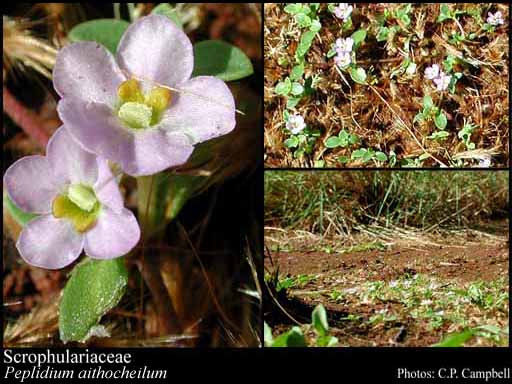- Reference
- Gen.Pl. [Jussieu] 117 (1789)
- Name Status
- Current

Scientific Description
Common name. Foxglove Family.
Habit and leaf form. Shrubs and herbs (mostly), or herbaceous climbers, or trees, or lianas. ‘Normal’ plants, or plants of very peculiar form (when parasitic). Leaves well developed (usually), or much reduced (e.g. the parasitic Harveya, Hyobanche), or absent (e.g. the root parasite Lathraea). Plants non-succulent, or succulent (more or less, Bacopa, Lindernia); totally parasitic (Lathraea), or partially parasitic (commonly, concentrated in the Rhinantheae), or autotrophic. When parasitic, on roots of the host. Annual, or biennial, or perennial; plants with a basal concentration of leaves, or with neither basal nor terminal concentrations of leaves, or with terminal rosettes of leaves (sometimes, in Peplidium). Climbing (sometimes), or self supporting (mainly); the climbers stem twiners, or petiole twiners. Hydrophytic (e.g. ‘Ambulia’, = Limnophila), or helophytic, or mesophytic, or xerophytic (e.g. ericoid Selagineae); when hydrophytic, rooted. Leaves of aquatics submerged, or emergent, or floating. Heterophyllous (e.g. Hebe, Hydrotriche), or not heterophyllous. Leaves alternate, or opposite, or whorled; when alternate spiral, or four-ranked; ‘herbaceous’, or leathery, or fleshy, or membranous (rarely); petiolate to sessile, or perfoliate (occasionally); connate (occasionally?), or not connate (usually); sheathing, or non-sheathing; simple; epulvinate. Leaf blades dissected, or entire; if dissected pinnatifid, or palmately lobed, or much-divided (e.g. submerged leaves in Hydrotriche, Limnophila); pinnately veined, or palmately veined. Leaves without stipules. Leaf blade margins entire, or crenate, or serrate, or dentate. Leaves without a persistent basal meristem. Leaf anatomy. Hydathodes present (occasionally), or absent. Stem anatomy. Nodes unilacunar. Secondary thickening developing from a conventional cambial ring.
Reproductive type, pollination. Fertile flowers hermaphrodite. Unisexual flowers absent. Plants hermaphrodite. Entomophilous. Pollination mechanism conspicuously specialized (with loose-pollen mechanisms), or unspecialized.
Inflorescence and flower features. Flowers solitary, or aggregated in ‘inflorescences’; in cymes, in racemes, in spikes, in heads, and in panicles. The terminal inflorescence unit cymose, or racemose. Inflorescences terminal, or axillary; mainly racemes, spikes and thyrses, terminal peloric flowers common. Flowers bracteate, or ebracteate; bracteolate, or ebracteolate; minute, or small to medium-sized, or large; very irregular (usually — apart from peloric terminal flowers), or somewhat irregular (e.g. Verbascum, Bachopa, Elacholoma); not resupinate (usually), or resupinate (e.g. Lindernia hypandra). The floral asymmetry involving the perianth and involving the androecium, or involving the androecium. Flowers cyclic; tetracyclic. Free hypanthium absent. Hypogynous disk present. Perianth with distinct calyx and corolla; (7–)8–10(–13); 2 -whorled; isomerous, or anisomerous. Calyx 4 (the posterior member missing, or the anterior pair united), or 5, or 2; 1 -whorled; nearly always, more or less gamosepalous, or polysepalous (e.g. Dischisma); entire (e.g. in Centranthera), or lobed (usually); imbricate, or valvate; unequal but not bilabiate, or bilabiate, or regular; persistent; when K5, with the median member posterior. Corolla 4 (the posterior pair united), or 5(–8), or 3 (sometimes in Glossostigma); 1 -whorled; appendiculate (e.g. Lindernia), or not appendiculate; gamopetalous; imbricate, or valvate; bilabiate (usually), or unequal but not bilabiate, or regular (Verbascum, etc.); spurred (sometimes), or not spurred. Androecium (4–)5 (posterior member sometimes missing), or 2(–3) (sometimes the lower pair reduced or missing). Androecial members adnate (to the corolla); usually markedly unequal; free of one another (via the anthers), or coherent; 1 -whorled. Androecium exclusively of fertile stamens, or including staminodes. Staminodes when present 1 (the posterior member), or 2–3; representing the posterior median member, or the posterior-lateral pair. Stamens (2–)4(–5); usually didynamous; reduced in number relative to the adjacent perianth, or isomerous with the perianth; oppositisepalous; all alternating with the corolla members. Filaments appendiculate (sometimes spurred, in Lindernia), or not appendiculate. Anthers connivent (in pairs), or separate from one another, or cohering; dehiscing via longitudinal slits, or dehiscing via pores (e.g. in Bartsia, some Euphrasia); introrse; unilocular (Selagineae, according to Hutchinson), or bilocular (mostly); tetrasporangiate. Gynoecium 2(–3) carpelled. The pistil 2(–3) celled. Gynoecium syncarpous; synstylovarious to eu-syncarpous; superior. Ovary plurilocular; 2(–3) locular. Gynoecium median; stylate. Styles 1; attenuate from the ovary, or from a depression at the top of the ovary; apical. Stigmas 1, or 2; 1–2 - lobed; wet type, or dry type; papillate; Group II type and Group III type. Placentation axile (usually), or apical (Selagineae). Ovules 1 per locule (Selagineae), or 2–50 per locule (i.e. to ‘many’); pendulous (Selagineae), or pendulous to ascending; non-arillate; anatropous, or campylotropous, or hemianatropous.
Fruit and seed features. Fruit non-fleshy (usually), or fleshy (rarely); dehiscent (usually), or indehiscent (rarely), or a schizocarp (Selagineae, Lagotis). Mericarps 2, or 1 (one member often sterile or obsolete in Selagineae). Fruit when non-schizocarpic, a capsule (usually), or capsular-indehiscent (very rarely), or a berry. Capsules septicidal (usually), or loculicidal, or poricidal (occasionally), or splitting irregularly, or valvular. Seeds endospermic. Endosperm oily. Seeds minute, or small; winged, or wingless (often angled). Embryo well differentiated (usually), or weakly differentiated (Lathraea). Cotyledons 2 (reduced but distinguishable in Lathraea). Embryo chlorophyllous (3/3), or achlorophyllous (12/26); straight to curved. Seedling. Germination phanerocotylar.
Physiology, biochemistry. Aluminium accumulation not found. Photosynthetic pathway: C3 and C4.
Geography, cytology, number of species. World distribution: cosmopolitan. X = 6 (or more). 3000 species.
Economic uses, etc. Many are poisonous, a few are (e.g. Digitalis) or have been officinal, Halleria has edible fruit (umbinza).